Custody Agreements Samples & Templates
-
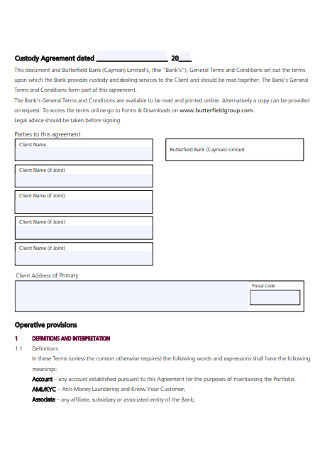
Client Custody Agreement
download now -
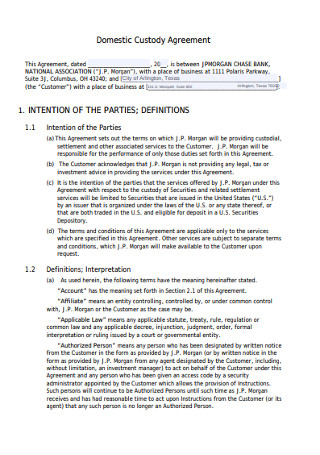
Domestic Custody Agreement
download now -
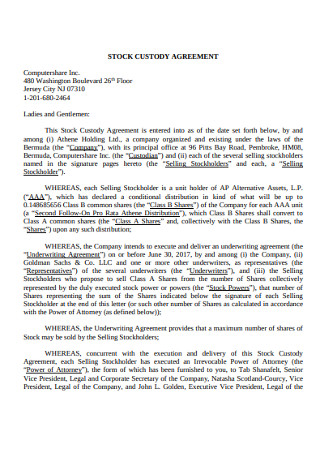
Stock Custody Agreement
download now -
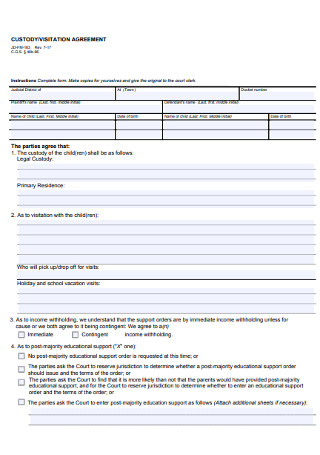
Custody Visitation Agreement
download now -
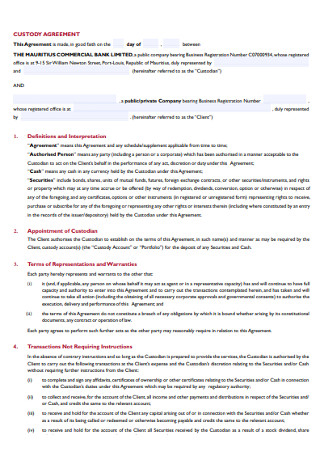
Corporate Custody Agreement
download now -
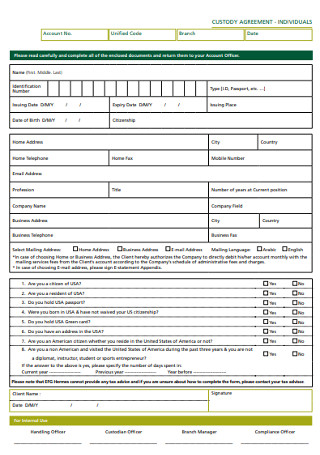
Individuals Custody Agreement
download now -
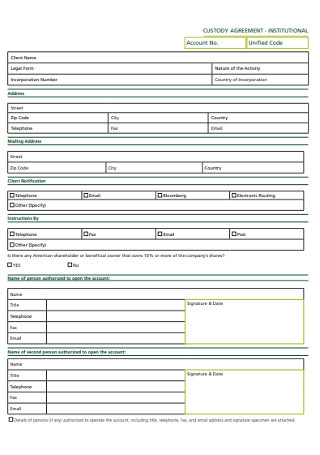
Insitutional Custody Agreement
download now -
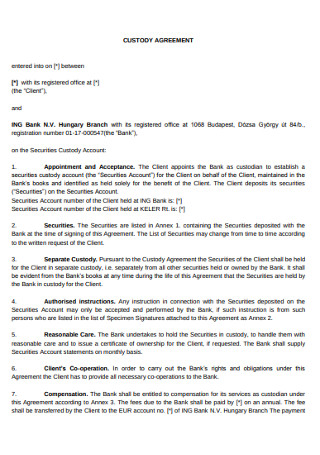
Sample Custody Agreement
download now -
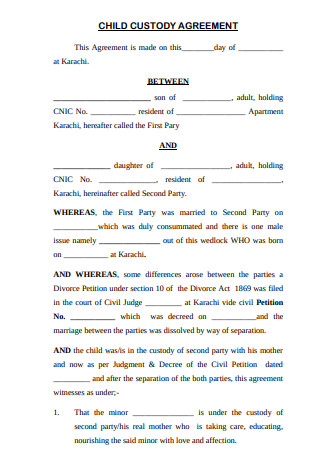
Sample Child Custody Agreement
download now -
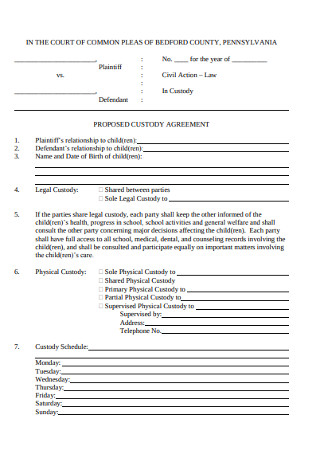
Proposed Custody Agreement
download now -
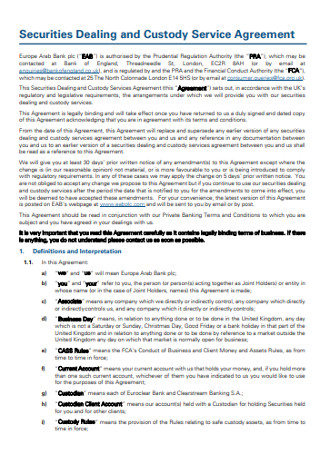
Custody Service Agreement
download now -
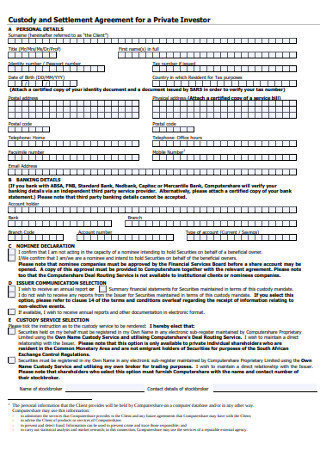
Custody and Settlement Agreement
download now -
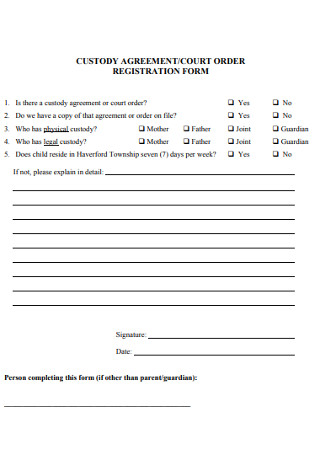
Custody Agreement Registration Form
download now -
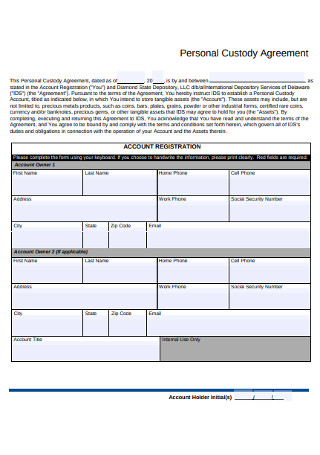
Personal Custody Agreement
download now -

Loss Sharing Custody Account Agreement
download now -
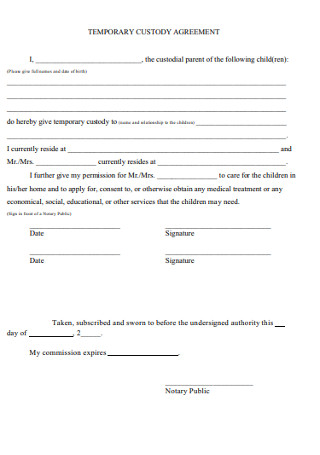
Temporary Custody Agreement
download now -
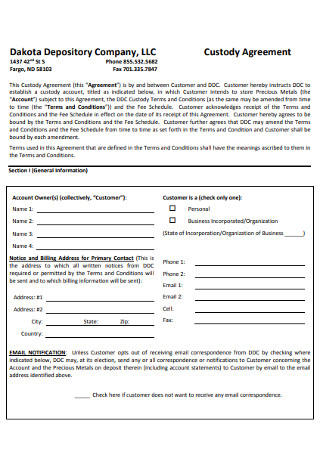
Company Custody Agreement
download now -
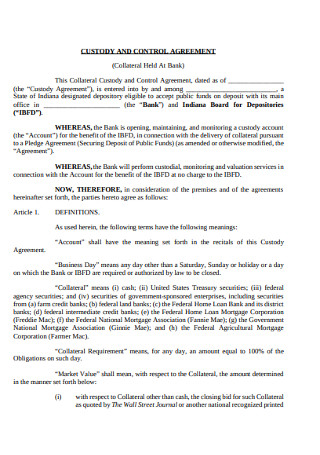
Custody and Control Agreement
download now -
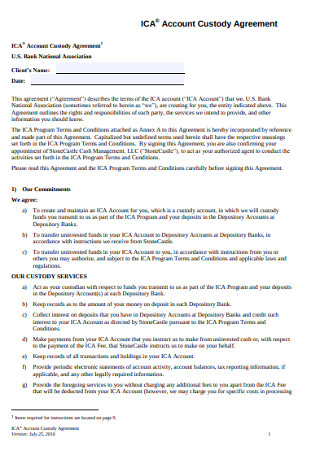
Standard Account Custody Agreement
download now -
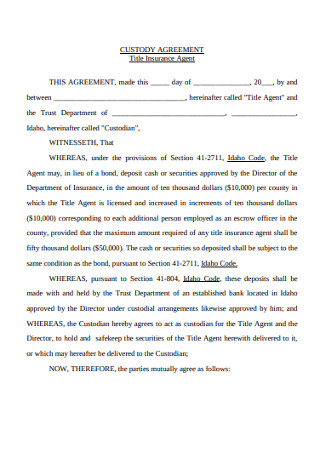
Insurance Agent Custody Agreement
download now -
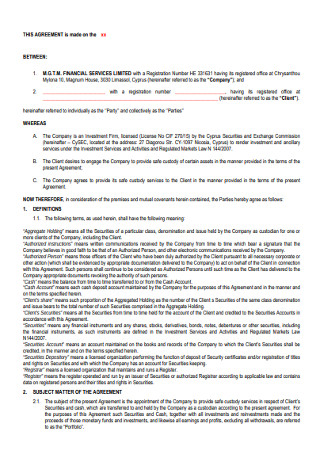
Safe Custody Agreement
download now -
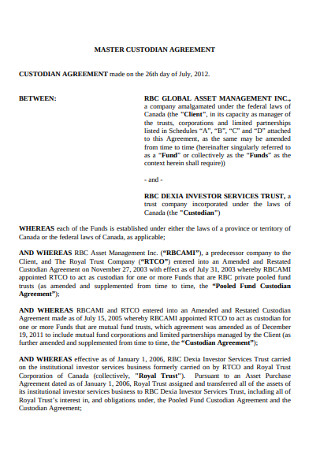
Master Custodian Agreement
download now -
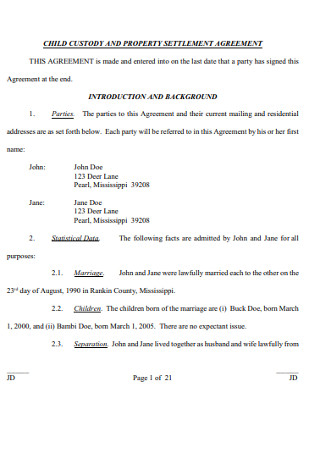
Child Custody and Property Settlement Agreement
download now -
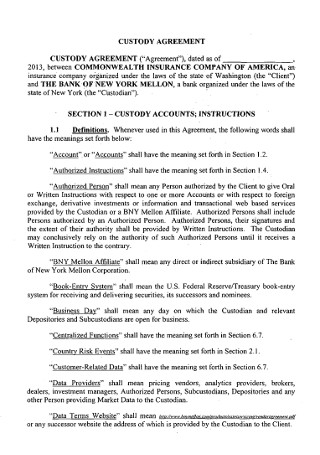
Insurance Company Custody Agreement
download now -
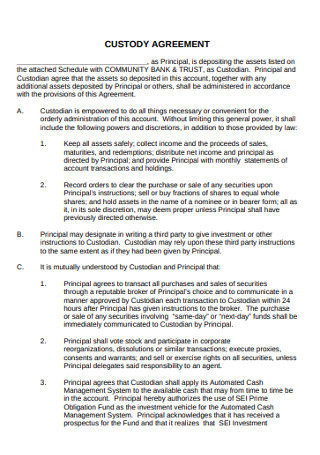
Bank Custody Agreement
download now -
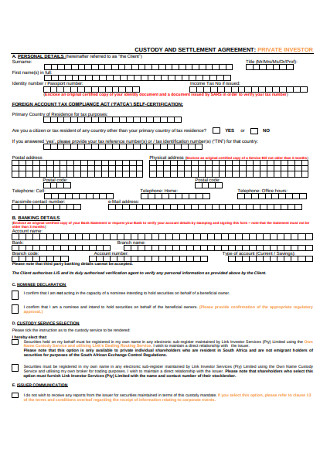
Basic Custody Settlement Agreement
download now -
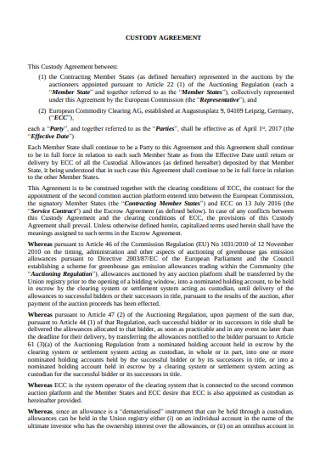
Simple Custody Agreement
download now -
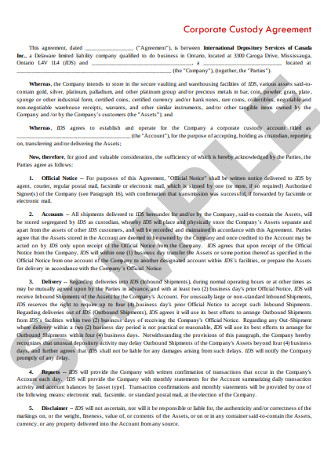
Basic Corporate Custody Agreement
download now -
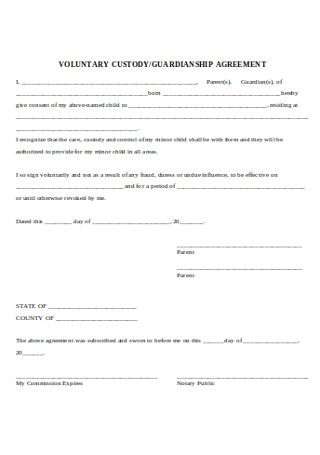
Voluntary Custody Agreement
download now -
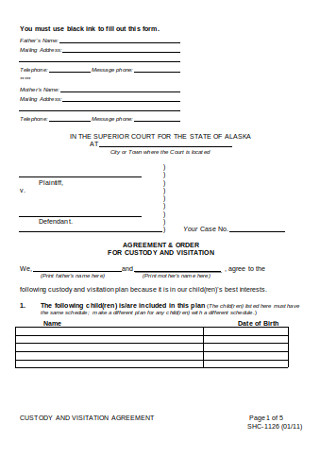
Custody and Visitation Agreement
download now
What is a Custody Agreement and Why is it Necessary?
In a general sense, custody means providing care for someone or guarding something. Offices and other organizations have custodians who are responsible for taking care of the equipment and supplies. They are the ones we call when we need to rent or borrow a particular property. Apart from guarding pieces of equipment, one can also provide custody over people. Particularly to people who are under the legal age or those who have underdeveloped mental faculties. However, having custody over other people is a more complicated process.
Discussions about a child’s custody often follow a divorce. It answers the questions on which parent will have the legal right and responsibility to take care of the children. It settles the arrangement of co-parenting. Even marriages that end up civilly have a possibility of going downhill because of unfair co-parenting arrangements. And it is the role of custody agreements to prevent and, somehow, mitigate the existing damages. Custody agreements consist of the provisions of the custody, child support, and visitation rights if ever one parent has full custody of the child.
Types of Child Custody
Custody agreements need the approval of a judge for it to be fully enforceable under different state laws. If the parents cannot decide on an arrangement on their own, the judge can look into the nature of their relationship to settle for them. The judge can also look into several other factors, such as the role of the parent as a caregiver. These factors have a significant bearing on the type of custody imposed on the parents and other caregivers of the children.
The Power of Ownership: Essence of Gaining Custody
Humans have a natural inclination in naming and labeling things. It is apparent how people take care of things that they own. There is a clear difference in how one takes care of something that is theirs and with something that they are tasked to care for. Aside from human behavior, it is also apparent in how we speak. The evolution of language reflects the development of a particular culture. The language that we share now has developed specific rules to show possession. Considering the integral link of language and culture, one can wonder just how important is custody and ownership for a person for it to develop a collective aspect.
“This is mine.” “That car is theirs.” It is relatively easy to decide an object’s ownership because it cannot speak for itself. But, when it comes to dealing with people, it bears certain levels of complexity. Saying that you own a person is blatantly inhumane and illegal. But, claiming that you have full physical custody of your children means that they are under your care. All of you are under the same household. As a matter of fact, most parents who have physical custody of their children also have legal custody over them. Having legal custody means that the parents can make long-term decisions for their children, which includes education, healthcare, and religion. All these areas are vital to the parent’s upbringing method.
A Closer Look Into Child Custody Cases
In most coming-of-age films, the lead character often lives alone with a parent who struggles with a divorce. A certain scene that is pivotal to the character’s development is an emotional confrontation with the parent conversing about the struggles of living in two homes because of custody bouts. More often than not, it is an exaggeration of what is happening in real life, but nonetheless, true to a certain extent.
For real life cases, the parents agree on amicable settlements with the best interest of their children in mind. If they fail to reach an agreeable arrangement, they call on the judgement of the court. The court then decides basing on several factors. They evaluate the capacity of each parent to provide for the daily needs of the children. More than the financial capacities, they also take into consideration the relationships and affiliations of each party. Including non-romantic relationship. For custody arrangements outside marriage or years after settling a divorce, each party may have new partners. For this reason, the court places emphasis on their established relationships. Aside from these factors, the court also considers the preference of the children. It answers the question of who they have a happier relationship with. Although, the court does not change their decision based on these preferences alone. They measure its relevance to the circumstance. Here is a landmark case where a child stood witness in the case of her parent’s custody trial for her and her sister.
From Witness to Judge
A judge considers several factors to come up with the best decision for a family that is bound to separate ways. They evaluate the capacities of the parents to foster a healthy environment for the child. Aside from the personal accounts of the parents, they also consider the preference of the children. An 11-year old Lisa Friederweitzer experienced this circumstance. She is now a Judge as a Family Court in the Bronx. In an article by The New York Times, she recalls the experience as something traumatizing for a child. Being held at court for hours and asked by random people about how her parents treat each other was a taxing task. The trial for their custody was during a time where the mother’s guardianship was highly favored. Judge Lisa, in fact, wanted to live with her father, but the ruling was for her mother. But, things took a turn when her father filed for a reassessment of the verdict because of some legal grounds, which were eventually proven. This experience was pivotal for Judge Friederweitzer. It lead her to her current occupation.
How to Express Custody Through Writing
In expressing one’s desire to have custody over their children, some parents go overboard with their emotions. They choose to appeal to the court and the other party by tugging on their heartstrings. Some even go beyond by undermining the other party and placing them in a negative light. But, this is not the proper process. There is a need to follow the legal process, and here are the steps to follow in writing a custody agreement.
Step 1: State Your Claims
Before deciding on the best type of custody agreement to follow, both parties need to state their claim through letters of declarations. In these letters, each parent should declare their relationship with the child. It must contain the details of their relationship before the separation and immediately after. These details can conclude whose presence the child prefers. Aside from this letter, character reference documents are also essential in finalizing a custody case. Character references are narratives from third-parties to show support to your claim. To put it simply, they serve as witnesses to your statements. In stating your claims for the custody—sole or joint, place your interest second to what your children actually deserve.
Step 2: Settle Visitation Arrangements
Deliberating the statements of the parties result in settling the nature of the custody arrangement. Regardless if it is a joint or sole agreement, it must contain details of the visitation rights. Although it may be more urgent for sole custody arrangements, joint custody cases also need a comprehensive one. Visitation agreements usually consist of the required visiting hours and the allowed places where the non-custodial parent can visit. It also covers where the child will celebrate the holidays or summer vacations. Both parties can come up with an agreement that the child can celebrate selected holidays with both of them. These situations are common for parents who share legal custody, but not physical.
Step 3: Develop a Parenting Plan
Aside from a comprehensive visitation arrangement, custody agreements must also have an official parenting plan. It is especially crucial for those who choose to have joint legal custody. Parenting plans are more concerned with making decisions for their children who are under the legal age of consent. Apart from the usual issues concerning legal custody, such as decisions on education, health care, and religious upbringing, the parenting plan also includes stipulations on how both parties will settle future disputes. Another thing to consider is that either party should also pitch in ideas on how they will make arrangements with the current agreement.
Step 4: Establish Child Support Deal
A custody agreement will never be complete without a child support deal. As the entire arrangement is for the best interest of the child, the child support deal also does the same. Child support is a periodic payment made by the non-custodial parent to support the ongoing growth of the child. The parent is required to pay a flat rate for each child. For joint arrangements, both parties can choose to agree on the payment amicably. Paying for child support is also a civil responsibility as there are laws that regulate it. Non-payment has corresponding consequences under federal regulations.
It is not impossible to end relationships without spewing out hurtful words and statements that hurt deeper than knives. But, unfair custody agreements complicate amicable separations. The complications can lead to costly court hearings for arrangements that can be settled with well-written child custody agreements. Issues regarding visitation, co-parenting, and child custody are the essential stipulations in a child custody contract. For hopeless romantics, a divorce may seem to be an end of a fairy tale. But for parents, the happy ever after that matters most is their relationship with their children. The well-being of the children comes first.
